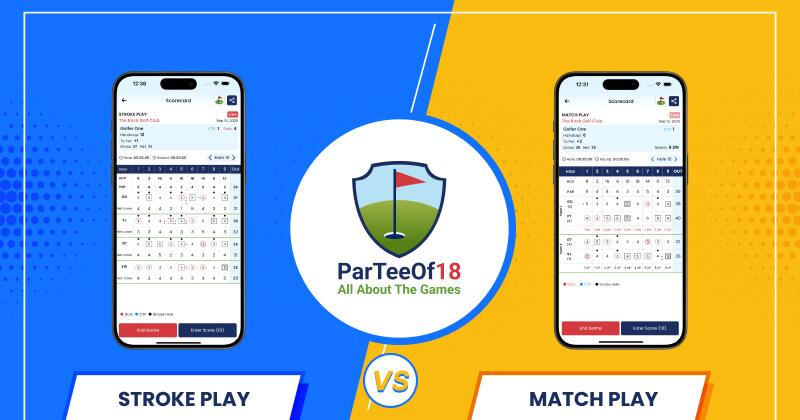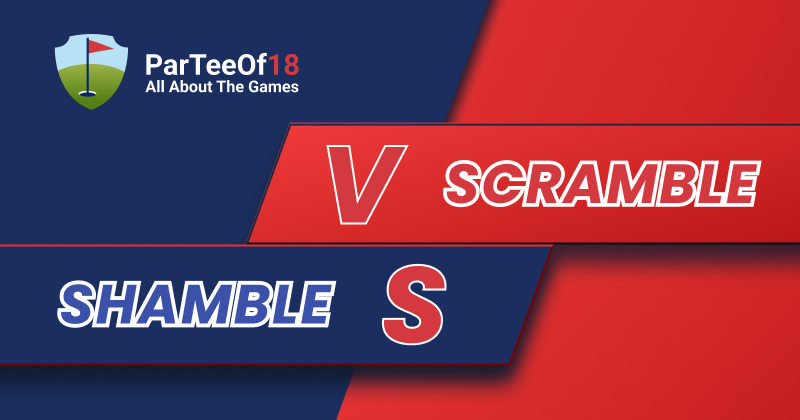Are you curious about the differences between stroke play and match play in golf? This simple guide offers a clear explanation of Stroke Play vs Match Play — Rules, Scoring, and Strategy Explained. Many golfers often wonder which format is more challenging, more strategic, or simply more enjoyable to play. Both are popular in competitive tournaments and weekend rounds, yet each follows unique rules and rewards different playing styles. In this blog, you’ll get a complete understanding of both formats — how they work, how scoring differs, and what strategies can help you perform better in each.
Whether you’re new to golf or already comfortable with competitive play, understanding these two scoring formats will deepen your knowledge of the game. You’ll be able to decide which format suits your goals, your mindset, and your playing group. Keep reading to explore how stroke play and match play bring out different kinds of focus, pressure, and excitement on the course — and learn why the USGA’s guide on Forms of Play: Match Play and Stroke Play remains the go-to resource for understanding both formats at every level of the game.
Quick Overview: Stroke Play vs Match Play
Golfers often compare stroke play vs match play to understand how each format shapes the experience on the course. At first glance, both seem straightforward — you hit your shots, count your strokes, and aim for the lowest total. But once you dive in, the mindset and goals between these two formats couldn’t be more different.
In stroke play, every shot across all 18 holes matters because your total number of strokes determines your score. It rewards steady play, consistency, and focus over the entire round. Match play, on the other hand, is all about winning individual holes — you compete directly against your opponent rather than the entire field. That means one bad hole doesn’t ruin your game; you can bounce back on the very next one.
Both formats challenge golfers in unique ways. Stroke play tests endurance and discipline, while match play brings out strategy, competitiveness, and mental toughness. Understanding these core differences is the first step to mastering how you approach each style — whether you’re chasing your personal best or facing an opponent head-to-head.
Key Differences Between Match Play and Stroke Play
While both are popular golf formats, the real test begins when you compare how they’re scored, played, and strategized. The key differences between matchplay and strokeplay go far beyond counting strokes — they influence how golfers think, plan, and respond under pressure. Each format rewards a different type of skill and mindset: stroke play focuses on consistency across every hole, while match play emphasizes short bursts of strategic excellence.
Let’s first break down what truly sets these two formats apart and how they shape a golfer’s overall approach to the game.
| Aspect | Stroke Play | Match Play |
|---|---|---|
| Scoring System | Every stroke across 18 holes counts toward your total; the lowest total wins. One mistake can impact the entire round. | Each hole is a separate contest; win more holes than your opponent to win the match. One bad hole doesn’t affect the next. |
| Strategy & Tactics | Emphasizes consistency, smart shot selection, and risk management to protect the overall score. | Strategy shifts hole-by-hole; you can take bold risks or play defensively depending on your opponent’s position. |
| Pressure & Consistency | Pressure builds over the full round — every shot matters. Mental discipline and steady focus are essential. | Pressure resets each hole. Success depends on composure in head-to-head moments and handling key situations. |
| Handicapping | Handicap adjusts the total round score to level competition across differing skill levels. | Handicap is applied hole-by-hole, giving strokes on specific holes to keep matches fair and competitive. |
Advantages and Challenges
Both stroke play and match play come with their own strengths and obstacles. Here’s how they compare:
Stroke Play – Advantages:
- Encourages consistency and focus over all 18 holes.
- Rewards smart course management and risk control.
- Provides a true measure of overall skill and endurance.
Stroke Play – Challenges:
- A single bad hole can greatly affect the total score.
- Demands mental toughness to recover from mistakes.
- Can feel less forgiving for beginners or casual players.
Match Play – Advantages:
- Each hole offers a new opportunity — one bad hole doesn’t ruin the round.
- Promotes strategy, competitiveness, and direct player interaction.
- Keeps rounds engaging, especially in friendly or team settings.
Match Play – Challenges:
- Pressure intensifies in close head-to-head moments.
- Strategic decisions must adapt constantly to an opponent’s play.
- May not reflect overall consistency across the full course.
Concession & Penalties in Match Play vs Stroke Play
While both formats follow the same rulebook, how they handle player decisions and mistakes differs noticeably. Match play allows certain leniencies through concessions, whereas stroke play is stricter, with every penalty directly affecting your total score.
Concession in Match Play
In match play, a player can concede a putt, hole, or even the match at any moment. This gesture ends that part of play immediately — no further strokes are needed. Concessions often speed up the round and can also be used tactically to manage momentum or maintain sportsmanship. Once made, a concession is final.
Penalties in Stroke Play
Stroke play applies penalties strictly to scoring — every stroke and infraction counts. Hitting out of bounds, playing the wrong ball, or grounding your club in a bunker all carry specific penalties that add to your total. There’s no option to concede, so precision and rule awareness are vital.
Note: Grasping how concessions and penalties function differently helps golfers adjust their decision-making. Match play rewards situational awareness; stroke play demands consistency and discipline.
Common Strategies for Achieving Victory
Success in golf depends not just on skill but on how you adapt your strategy to the format you’re playing. Match play and stroke play reward different mindsets — one focuses on beating your opponent hole-by-hole, while the other demands steady performance across every shot. Understanding these strategic nuances can help you play smarter and stay competitive in both styles.
Also Checkout: Best Ball vs Scramble
Tips for Winning at Match Play
Match play is as much about psychology as it is about precision. Since you’re competing directly against another golfer, every hole becomes its own contest. Here’s how to gain the edge:
- Play the player, not the course. Adapt your shot selection based on your opponent’s position — take more risk when they’re in trouble and stay conservative when they’re safe.
- Apply pressure early. Winning a few early holes can unsettle your opponent and shift the mental balance in your favor.
- Know when to concede. Offering a smart concession can keep play moving and display confidence — it’s part of the strategic rhythm of match play.
- Stay composed after a loss. Each hole resets the score; a single bad hole doesn’t define the match.
- Use your strengths strategically. Lean on your best shots when momentum matters most — like the closing stretch or a tight par save.
Also Checkout: Shamble vs Scramble
Tips for Winning at Stroke Play
In stroke play, your only true opponent is the scorecard. Every stroke counts, and consistency across the entire round determines success. Here’s how to excel:
- Prioritize smart course management. Avoid unnecessary risks — play to your strengths and aim for safe targets when hazards are in play.
- Keep emotions in check. One bad shot or hole can snowball quickly. Focus on recovery and maintaining rhythm.
- Know your scoring zones. Sharpen your approach shots and putting — these areas save the most strokes over 18 holes.
- Track performance metrics. Use a golf app or score tracker to identify patterns, like missed fairways or three-putts, and adjust your practice accordingly.
- Finish strong. Many players lose focus on the last few holes. Treat the closing stretch as a fresh mini-round to maintain intensity.
Stroke Play vs Match Play: Tournaments and Competitions
Both formats play vital roles in golf’s competitive world, shaping how tournaments unfold and how players approach the game. While stroke play rewards steady precision across every hole, match play thrives on one-on-one pressure and strategic risk-taking.
Match Play Tournaments
In match play, golfers compete hole by hole — the player who wins the most holes wins the match. This makes for thrilling turnarounds and tense finishes.
Famous examples:
- The Ryder Cup – A team showdown between the U.S. and Europe, rich in emotion and rivalry.
- WGC-Dell Technologies Match Play – Features elite golfers in head-to-head brackets.
Stroke Play Tournaments
Stroke play defines golf’s biggest stages — every stroke counts toward the total score, and the lowest score wins. It demands focus, consistency, and endurance over multiple rounds.
Iconic examples:
When to Choose Stroke Play or Match Play?
Choosing between stroke play and match play depends on what kind of golfing experience you’re after. Both formats test your skills but in different ways — one rewards steady performance, while the other thrives on pressure and adaptability.
Pick Stroke Play if you enjoy tracking your performance over time, competing against the course itself, and aiming for personal improvement. It’s ideal for golfers who prefer structure, accuracy, and consistent play over multiple rounds.
Go for Match Play if you like direct competition and strategic decision-making. It’s perfect for friendly rivalries, club championships, or team formats where every hole brings new dynamics.
If your focus is on improving your scoring consistency or monitoring progress across rounds, stroke play is the smarter choice. But if you want a fast-paced, interactive format that tests your nerves and creativity, match play keeps the adrenaline flowing.
Conclusion
In the end, stroke play vs match play isn’t about which is better — it’s about what suits your goals and playing style. Stroke play rewards long-term focus and precision, while match play celebrates tactical thinking and head-to-head competition.
Whichever format you choose, track your rounds with a reliable golf scoring app to monitor progress and make smarter on-course decisions. And if you’re curious how your skills stack up, try using a golf handicap estimator to gauge your performance across formats.
Both tools help you understand your strengths, refine your strategy, and enjoy golf at its best — one hole, one round, and one learning experience at a time.
FAQs
Is PGA match play or stroke play?
Most PGA Tour events are stroke play tournaments, where players compete based on their total number of strokes over multiple rounds. However, a few special events, like the WGC-Dell Technologies Match Play, use the match play format for a head-to-head competition style.
Is the Masters stroke play or match play?
The Masters Tournament is a stroke play event. Players complete four rounds at Augusta National, and the golfer with the lowest total score after 72 holes wins the Green Jacket.
Can you play stroke play and match play at the same time?
Technically, no — both formats have different scoring systems and rule interpretations. However, some casual rounds combine elements of both for fun, like tracking your total score (stroke play) while also seeing who wins the most holes (match play). Officially, they’re treated as separate formats under the Rules of Golf.
What is the main difference in stroke play vs match play?
The main difference lies in how scoring works. In stroke play, every stroke counts toward your total score for the round. In match play, each hole is its own contest — whoever takes fewer strokes on that hole wins it.
How do the rules differ in match play vs stroke play?
The core rules remain the same, but their application differs. In match play, some penalties (like playing out of turn) are settled between players, while in stroke play, penalties automatically add to your score. Match play allows concessions; stroke play does not.
Which format, match play or stroke play, is more suitable for a casual game?
For most social or weekend rounds, match play is the better fit. It’s quicker, less pressured, and keeps everyone engaged hole by hole — even if someone has a rough start. Stroke play works better when you want to track overall improvement or prepare for formal tournaments.
Also



